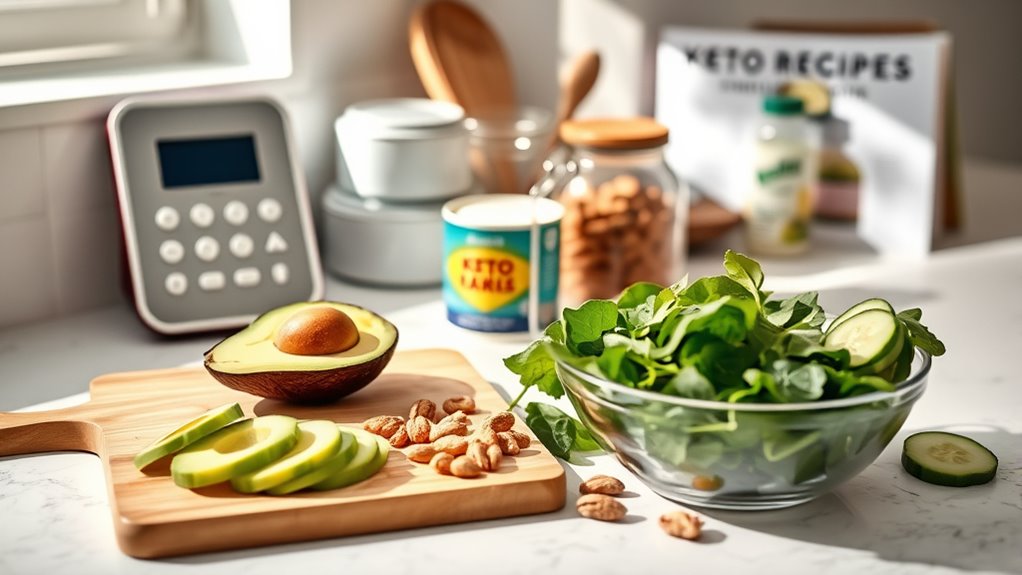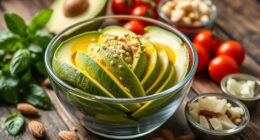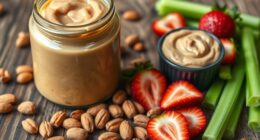To start a keto diet, plan simple meals focused on high-fat, moderate-protein, and low-carb foods like meats, low-carb vegetables, and healthy fats. Stock your kitchen with keto-friendly snacks and ingredients, and prepare meals in advance to stay on track. Create a motivating environment that supports your goals and be patient as your body adjusts. Keep consistent with your routines, and you’ll soon find it easier to maintain this lifestyle for good.
Key Takeaways
- Gradually reduce carbohydrate intake to 20-50g daily, replacing carbs with healthy fats and moderate protein.
- Plan and batch-cook keto-friendly meals using familiar, whole foods like meats, low-carb vegetables, and healthy fats.
- Stock supportive snacks such as nuts, cheese, and boiled eggs to curb cravings and maintain energy levels.
- Read labels carefully to avoid hidden carbs and sugars in processed foods and condiments.
- Build a consistent routine, create a keto-friendly environment, and stay patient during initial adaptation.

Starting a keto diet can seem overwhelming at first, but with the right approach, it becomes manageable and even enjoyable. The key is to plan ahead, so you’re never caught unprepared. One of the best ways to do this is by focusing on keto meal prep. Spend some time each week preparing meals that fit your new macronutrient goals. This way, you avoid last-minute temptations or grabbing unhealthy options when hunger strikes. Keep your prep simple—cook large batches of protein, like chicken or beef, and pair them with low-carb vegetables such as spinach or zucchini. Use healthy fats like olive oil, avocado, or butter to add flavor and satiety. When you have your meals ready, sticking to your carb limit becomes easier, and you’ll find yourself less likely to reach for non-keto snacks.
Plan weekly keto meals with simple, batch-cooked proteins and low-carb vegetables to stay on track effortlessly.
In addition to meal prep, stocking up on keto friendly snacks is essential. These snacks help you stay on track during busy days or between meals when cravings hit. Good options include nuts and seeds, cheese sticks, boiled eggs, or sliced cucumbers with cream cheese. Having these readily available reduces the temptation to reach for high-carb chips or sweets. Remember, the goal is to keep your carbohydrate intake low—usually under 20-50 grams per day—so choose snacks that are nutrient-dense but low in carbs. This not only helps with weight loss but also keeps your energy levels stable throughout the day.
Another helpful tip is to familiarize yourself with keto-friendly ingredients and recipes. Search for simple, tasty recipes that incorporate foods you already enjoy. When grocery shopping, focus on fresh, whole foods and avoid processed items, which often contain hidden carbs or sugars. Reading labels becomes a crucial skill here; many packaged foods marketed as “low-carb” or “keto” can still contain ingredients that kick you out of ketosis. Planning your meals and snacks in advance ensures you always have something keto-friendly on hand, making it easier to resist temptations and stay consistent. Additionally, understanding the importance of contrast ratio can help you select the best tools and environments for a successful keto lifestyle, especially when it comes to creating a comfortable and motivating space at home.
As you start your keto journey, be patient and give your body time to adapt. Initially, you might experience some adjustments like the “keto flu,” but this usually passes quickly. Keep your focus on your meal prep and snacks, and you’ll build a sustainable routine. Over time, these habits will become second nature, and you’ll find it easier to enjoy the benefits of ketosis—more energy, weight loss, and better mental clarity.
Frequently Asked Questions
Can I Eat Out While on a Keto Diet?
Yes, you can eat out while on a keto diet. Just follow restaurant etiquette by choosing low-carb options and asking for modifications if needed. Use meal prep tips like checking menus online beforehand and selecting dishes with healthy fats and proteins. Opt for grilled meats, salads without sugary dressings, and avoid bread or pasta. Staying mindful of ingredients helps you enjoy dining out without compromising your keto goals.
How Long Does It Take to See Results?
You’ll typically see results within 1 to 2 weeks of following ketogenic meal plans and sticking to low carb recipes. As you maintain your keto diet, your body shifts into fat-burning mode, leading to weight loss and increased energy. Keep in mind, individual results vary depending on your starting point and consistency. Stay dedicated, and you’ll notice changes in your body and overall wellness fairly quickly.
Are There Any Keto-Friendly Snacks?
Keto-friendly snacks keep your ketosis on track. You can try tasty keto snack ideas like cheese crisps, nuts, and hard-boiled eggs. For low carb snack options, consider celery with cream cheese or beef jerky. These snacks are satisfying and support your keto journey. Keep exploring options that are easy to prepare, portable, and packed with healthy fats to stay energized and curb cravings throughout your day.
What Are Common Keto Flu Symptoms?
You might experience keto flu symptoms like fatigue, headaches, dizziness, irritability, and muscle cramps. To ease these symptoms, focus on keto flu remedies such as staying hydrated and maintaining electrolyte balance with magnesium, potassium, and sodium. Rest well, and consider adding bone broth or electrolyte drinks to your routine. These steps help your body adjust faster, reducing discomfort and supporting your shift into ketosis smoothly.
Is a Keto Diet Safe for Everyone?
A keto diet isn’t for everyone, and you should be cautious. While it can be safe for many, some people with certain health conditions or on specific medications might face risks. Always review keto meal plans with your healthcare provider and consider keto supplements to fill nutritional gaps. If you experience adverse effects, stop immediately. If you’re healthy, it can be a powerful way to boost your energy and reach your goals—just stay informed!
Conclusion
Starting a keto diet is like planting a new seed—you’ll need patience and consistency to see it grow. Stick to your plan, stay committed, and don’t get discouraged by small setbacks. Remember, every step you take is a building block toward your goal. With dedication, you’ll find yourself thriving on this low-carb journey, just like a tree reaching toward the sun—growing stronger and more vibrant each day. Keep going, and you’ll see the results you’re aiming for.









